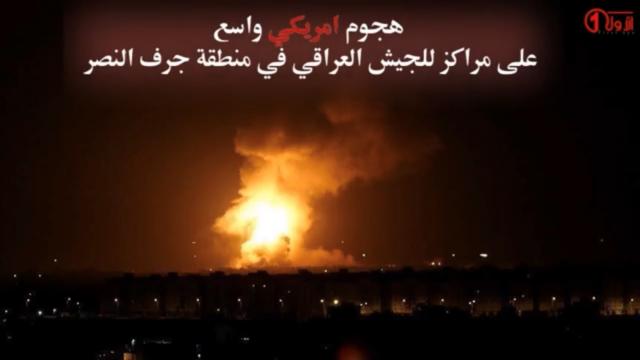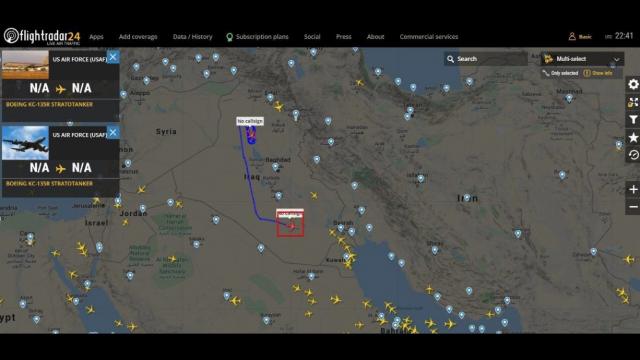Part of a series: Militia Spotlight
or see Part 1: How to Use Militia Spotlight
Media www.rajawalisiber.com – The KH-affiliated media group Unit 10,000 planted disinformation about a nonexistent U.S. airstrike, stoked the story, and then tried to remove its fingerprints from the original “fake news.”
In the early hours of January 19 (Iraq time), the muqawama propaganda channels in Iraq began agitatedly reporting that airstrikes had caused a large explosion at the Kataib Hezbollah (KH) base area of Jurf al-Sakhar, speculating that a number of individuals were dead and wounded. Tensions were high, with the clock running out on the Trump administration and militias on high alert for a last-minute U.S. strike by the outgoing president.
In fact, the strike never happened. Militia channels had dredged-up old photographs as “evidence” of the attack, as well as old statements of clerics repurposed as condemnations of the strike. Then, after a day of actively stoking the rumors, KH propagandists tried to erase the trail leading to their role in promoting the story as it became clear that only an electricity pylon had been blown up in a minor act of militancy.
How KH Uses Disinformation
Throughout January 19, the KH-affiliated Telegram channel Unit 10,000 drove almost all of the information flow. The wider muqawama network of large and small Telegram accounts then amplified the message and crowdsourced new “elements” to the story, such as rumors of casualty numbers. But with hindsight, Unit 10,000’s initial stirring of the pot appears calculated. Where other channels operated reactively and posted messages with a panicked tone, Unit 10,000 remained calm, drip-feeding false information into the media ecosystem throughout the night.
By late afternoon on January 19, Unit 10,000 had quietly removed some of their primary statements. Sabereen News, however, continued to develop the story—long after mainstream reporting had dismissed news of airstrikes as fake. Sabereen is exceptionally influential among militias, and so by continuing to post about this story, the channel prolonged the narrative among the muqawama. Meanwhile, the information introduced by Unit 10,000 (but later removed) was quickly picked up by major media outlets in the Middle East and reported as originating from security sources—ensuring the untruths revealed by the group entered the mainstream media.
Unit 10,000 also headed off any counter-narratives early, stating (in a subsequently deleted message), “According to our experience with the [government media] cell, the strike will be denied, or a story will be conducted about the strike being ISIS crooks, or some kind of mistake.”
Enter the Pylon
It was subsequently revealed that a large electricity pylon was destroyed west of Jurf al-Sakhar on January 18 by some kind of explosion. Sabereen-affiliated Telegram channels quickly blamed the Islamic State and posted photographs of the damage. One shared statement read:
“At 4 a.m. ISIS blew up a number of electricity pylons in the area linking Amiriyah Fallujah and the desert area near Jurf. Observers have indicated that the airstrikes that hit the area at 1 a.m., and subsequent evacuation of security sites, caused a gap that ISIS terrorist gangs exploited.”
Known Sabereen-affiliated channels reposted similar messages. The network appears to recognize that the image of U.S. strikes on Jurf al-Sakhar needed to shift to a (rather implausible) U.S. strike on a pylon in the middle of nowhere. Yet the messaging was not perfectly unified.
In particular, KH affiliates posted a slightly different message. Kaf (the most official KH channel) posted:
“According to Kataib Hezbollah military spokesman Jaafar al-Husseini: The criminal sabotage operations that affected electricity transmission towers north of Babylon bear the hallmarks of criminal gangs with malicious motives, not much different from ISIS. The criminal operation took place during a suspension of operations by our brothers in the Iraqi army. The bombing of the pylons coincided with heavy enemy drone activity.”
Lessons from a Disinformation Operation
Whether the fake January 19 story was started by jumpiness or deliberately, the KH-affiliated Unit 10,000 kept stoking that narrative even after KH seemingly realized it had not been attacked. Middle Eastern journalists are increasingly in the habit of citing muqawama outlets like Unit 10,000 as credible security sources, which then puts the story into mainstream Arabic media, with potential feedback into global media. Then Unit 10,000 quietly removed its fingerprints from the original seeding of the disinformation.
Militia Spotlight was watching and archiving in realtime, however, allowing us to trace and document the origin of the disinformation and which groups amplified it, even after they probably knew it was false. This could be “on the fly” improvisation—taking a potentially embarrassing overreaction and turning it into an information operation to fire up the muqawama support base—or it could be deliberate.
Regardless, “Pylon-Gate” shows an agile media network, able to disseminate genuine news one moment and then misinformation, disinformation, or mal-information the next. Led by Unit 10,000, muqawama outlets saturated the media and information environment from the outset, meaning everything anyone knew about the events of January 18-19 was influenced by the muqawama line.



